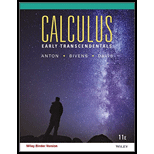Problem 1QCE: Let G be a solid whose surface is oriented outward by the unit normal n, and let Fx,y,z denote a... Problem 2QCE: The outward flux of Fx,y,z=xi+yj+zk across any unit cube is . Problem 3QCE: If Fx,y,z is the velocity vector field for a steady-state incompressible fluid flow, then a point at... Problem 4QCE: If F(r)=cr3r is an inverse-square field, and if is a closed orientable surface that surrounds the... Problem 1ES: Verify Formula (1) in the Divergence Theorem by evaluating the surface integral and the triple... Problem 2ES: Verify Formula (1) in the Divergence Theorem by evaluating the surface integral and the triple... Problem 3ES: Verify Formula (1) in the Divergence Theorem by evaluating the surface integral and the triple... Problem 4ES: Verify Formula (1) in the Divergence Theorem by evaluating the surface integral and the triple... Problem 5ES: Determine whether the statement is true or false. Explain your answer. The Divergence Theorem... Problem 6ES: Determine whether the statement is true or false. Explain your answer. If G is a solid whose surface... Problem 7ES: Determine whether the statement is true or false. Explain your answer. The continuity equation for... Problem 8ES: Determine whether the statement is true or false. Explain your answer. Since the divergence of an... Problem 9ES: Use the Divergence Theorem to find the flux of F across the surface with outward orientation.... Problem 10ES: Use the Divergence Theorem to find the flux of F across the surface with outward orientation.... Problem 11ES: Use the Divergence Theorem to find the flux of F across the surface with outward orientation.... Problem 12ES: Use the Divergence Theorem to find the flux of F across the surface with outward orientation.... Problem 13ES: Use the Divergence Theorem to find the flux of F across the surface with outward orientation.... Problem 14ES: Use the Divergence Theorem to find the flux of F across the surface with outward orientation.... Problem 15ES: Use the Divergence Theorem to find the flux of F across the surface with outward orientation.... Problem 16ES: Use the Divergence Theorem to find the flux of F across the surface with outward orientation.... Problem 17ES: Use the Divergence Theorem to find the flux of F across the surface with outward orientation.... Problem 18ES: Use the Divergence Theorem to find the flux of F across the surface with outward orientation.... Problem 19ES: Use the Divergence Theorem to find the flux of F across the surface with outward orientation.... Problem 20ES: Prove that if r=xi+yj+zkand is the surface of a solid G oriented by outward unit normal, then... Problem 21ES: Use the result in Exercise 20 to find the outward flux of the vector field Fx,y,z=xi+yj+zk across... Problem 22ES: Let Fx,y,z=ai+bj+ck be a constant vector field and let be the surface of a solid G. Use the... Problem 23ES: Find a vector field Fx,y,z that has (a) positive divergence everywhere (b) negative divergence... Problem 25ES: Let Fx,y,z be a nonzero vector field in 3-space whose component functions have continuous first... Problem 26ES: Does the result in Exercise 25 remain true if the sphere is replaced by a cube? Explain. Problem 27ES: Prove the identity, assuming that F, , and G satisfy the hypotheses of the Divergence Theorem and... Problem 28ES: Prove the identity, assuming that F, , and G satisfy the hypotheses of the Divergence Theorem and... Problem 29ES: Prove the identity, assuming that F, , and G satisfy the hypotheses of the Divergence Theorem and... Problem 30ES: Prove the identity, assuming that F, , and G satisfy the hypotheses of the Divergence Theorem and... Problem 31ES: Prove the identity, assuming that F, , and G satisfy the hypotheses of the Divergence Theorem and... Problem 32ES: Use the Divergence Theorem to find all positive values of k such that Fr=rrk satisfies the condition... Problem 33ES: Determine whether the vector field Fx,y,z is free of sources and sinks. If it is not, locate them.... Problem 34ES: Determine whether the vector field Fx,y,z is free of sources and sinks. If it is not, locate them.... Problem 35ES: Determine whether the vector field Fx,y,z is free of sources and sinks. If it is not, locate them.... Problem 36ES: Determine whether the vector field Fx,y,z is free of sources and sinks. If it is not, locate them.... Problem 37ES: Let be the surface of the solid G that is enclosed by the paraboloid z=1x2y2 and the plane z=0. Use... format_list_bulleted


 Algebra and Trigonometry (MindTap Course List)AlgebraISBN:9781305071742Author:James Stewart, Lothar Redlin, Saleem WatsonPublisher:Cengage Learning
Algebra and Trigonometry (MindTap Course List)AlgebraISBN:9781305071742Author:James Stewart, Lothar Redlin, Saleem WatsonPublisher:Cengage Learning